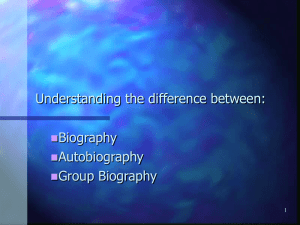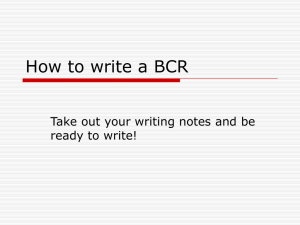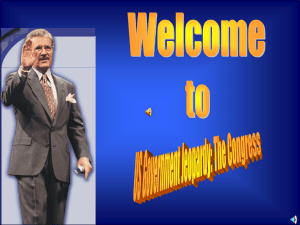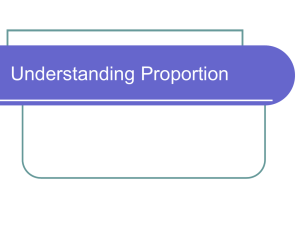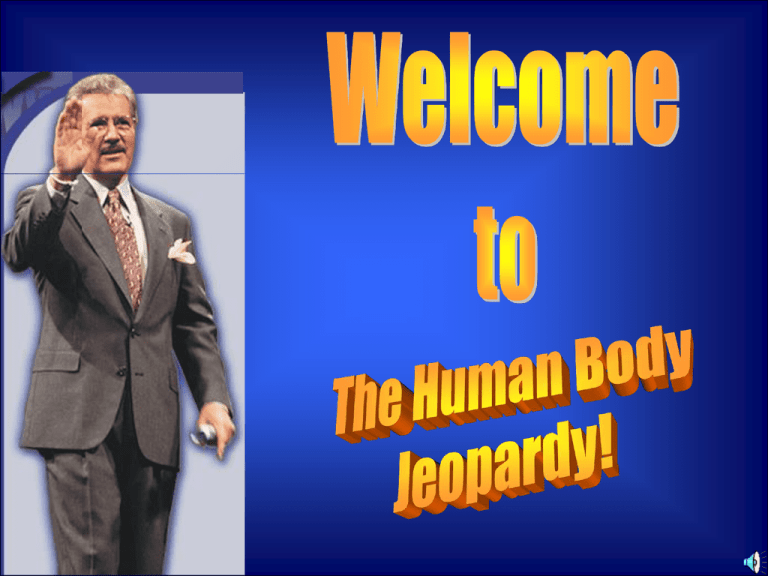
© Mark E. Damon - All Rights Reserved
© Mark E. Damon - All Rights Reserved
Another
Presentation
© 2012- All rights Reserved
© Mark E. Damon - All Rights Reserved
Directions:
•
Scroll through the presentation and enter the answers (which are really the
questions) and the questions (which are really the answers).
•
Enter in the categories on the main game boards.
•
As you play the game, click on the TEXT DOLLAR AMOUNT that the
contestant calls, not the surrounding box.
•
When they have given a question, click again anywhere on the screen to
see the correct question. Keep track of which questions have already been
picked by printing out the game board screen and checking off as you go.
•
Click on the “Game” box to return to the main scoreboard.
•
Enter the score into the black box on each players podium.
•
Continue until all clues are given.
•
When finished, DO NOT save the game. This will overwrite the program
with the scores and data you enter. You MAY save it as a different name,
but keep this file untouched!
© Mark E. Damon - All Rights Reserved
Round 1
Round 2
Final
Jeopardy
$
$
p
i
l
l
i
h
P
D
a
p
h
n
e
$
y
h
t
a
K
© Mark E. Damon - All Rights Reserved
Vocabulary
The
Circulatory
System
The Skeletal
System
More About
Body
Systems
The
Digestive
System
BONUS:
Human
Building
Blocks
Round 2
$100 $100
$100
$100 $100
$100
Final
Jeopardy
$200 $200
$200
$200 $200
$200
Scores
$300 $300
$300
$300 $300
$400 $400
$400
$400 $400
$500 $500
$500
$500
© Mark E. Damon - All Rights Reserved
$100
A body part made of different kinds
of tissues that work together to
perform a particular job is _____.
(a) a tissue
(b) an organ system
(c) a muscle
(d) an organ
© Mark E. Damon - All Rights Reserved
$100
(d) an organ
Scores
© Mark E. Damon - All Rights Reserved
$200
The bundle of nerve tissue that
carries messages to and from
the brain is the _____.
(a) esophagus
(b) spinal cord
(c) alveoli
(d) trachea
© Mark E. Damon - All Rights Reserved
$200
(b) spinal cord
Scores
© Mark E. Damon - All Rights Reserved
$300
The main muscle that controls the
movement of air into and out of the
body is the _____.
(a) alveoli
(b) trachea
(c) diaphragm
(d) capillary
© Mark E. Damon - All Rights Reserved
$300
(c) diaphragm
Scores
© Mark E. Damon - All Rights Reserved
$400
An organ made of bundles of
fibers. Smooth, cardiac, and
skeletal are types of _____.
(a) muscle
(b) tissue
(c) nerves
(d) blood vessels
© Mark E. Damon - All Rights Reserved
$400
(a) muscle
Scores
© Mark E. Damon - All Rights Reserved
$500
A group of cells of the same type that
work together to perform a certain
job is _____.
(a) a tissue
(b) an organ system
(c) a muscle
(d) an organ
© Mark E. Damon - All Rights Reserved
$500
(a) a tissue
Scores
© Mark E. Damon - All Rights Reserved
$100
A tiny, thin-walled blood vessel is
_____.
(a) a vein
(b) a joint
(c) a capillary
(d) an artery
© Mark E. Damon - All Rights Reserved
$100
(c) a capillary
Scores
© Mark E. Damon - All Rights Reserved
$200
A blood vessel that carries blood
away from the heart is _____.
(a) a capillary
(b) an artery
(c) a vein
(d) alveoli
© Mark E. Damon - All Rights Reserved
$200
(b) an artery
Scores
© Mark E. Damon - All Rights Reserved
$300
A blood vessel that carries blood
to the heart is _____.
(a) a capillary
(b) an artery
(c) a vein
(d) alveoli
© Mark E. Damon - All Rights Reserved
$300
(c) a vein
Scores
© Mark E. Damon - All Rights Reserved
© Mark E. Damon - All Rights Reserved
$400
What is the path that blood follows
through the body, beginning at the
heart?
(a) heart, capillaries, arteries, veins, heart
(b) heart, arteries, capillaries, veins, heart
(c) heart, veins, capillaries, arteries, heart
(d) heart, capillaries, veins, arteries, heart
© Mark E. Damon - All Rights Reserved
$400
(b) heart, arteries, capillaries,
veins, heart
Scores
© Mark E. Damon - All Rights Reserved
$500
What kinds of muscles make up
the walls of the heart?
(a) capillary
(b) cardiac
(c) smooth
(d) skeletal
© Mark E. Damon - All Rights Reserved
$500
(b) cardiac
Scores
© Mark E. Damon - All Rights Reserved
$100
A hard organ that helps support
and move the body is a _____.
(a) spinal cord
(b) bone
(c) muscle
(d) joint
© Mark E. Damon - All Rights Reserved
$100
(b) bone
Scores
© Mark E. Damon - All Rights Reserved
$200
Bones fit together in different
ways. Where is there a ball and
socket joint in your body?
(a) head
(b) shoulder
(c) knee
(d) neck
© Mark E. Damon - All Rights Reserved
$200
(b) shoulder
Scores
© Mark E. Damon - All Rights Reserved
$300
A place where two bones meet is
a _____.
(a) diaphragm
(b) bone
(c) muscle
(d) joint
© Mark E. Damon - All Rights Reserved
$300
(d) joint
Scores
© Mark E. Damon - All Rights Reserved
$400
What is the name of the stringy
tissues that connect bones
together?
(a) capillaries
(b) joints
(c) ligaments
(d) tendons
© Mark E. Damon - All Rights Reserved
$400
(c) ligaments
Scores
© Mark E. Damon - All Rights Reserved
$500
Stella is preparing a report about
human skeletons. Which item
should NOT be in her report?
(a) The skeleton helps us move.
(b) The skeleton helps us digest our food.
(c) The skeleton protects the organs inside our
bodies.
(d) The skeleton supports our bodies and gives
them shape.
© Mark E. Damon - All Rights Reserved
$500
(b) The skeleton helps us digest
our food.
Scores
© Mark E. Damon - All Rights Reserved
$100
What are organs made of?
(a) large, individual cells
(b) specialized tissues
(c) muscle
(d) bone
© Mark E. Damon - All Rights Reserved
$100
(b) specialized tissues
Scores
© Mark E. Damon - All Rights Reserved
$200
In which tube does air travel from
your nose or mouth toward the
lungs?
(a) artery
(b) capillary
(c) trachea
(d) esophagus
© Mark E. Damon - All Rights Reserved
$200
(c) trachea
Scores
© Mark E. Damon - All Rights Reserved
$300
Which is the main sense being used
to catch the ball?
(a) hearing
(b) sight
(c) smell
(d) taste
© Mark E. Damon - All Rights Reserved
$300
(b) sight
Scores
© Mark E. Damon - All Rights Reserved
$400
Which systems work together to
provide the body’s cells with
nutrients?
(a) circulatory and digestive
(b) circulatory and respiratory
(c) respiratory and circulatory
(d) respiratory and nervous
© Mark E. Damon - All Rights Reserved
$400
(a) circulatory and digestive
Scores
© Mark E. Damon - All Rights Reserved
$500
Which two organs run parallel to
each other?
(a) stomach and esophagus
(b) esophagus and intestine
(c) eyes and ears
(d) spinal cord and esophagus
© Mark E. Damon - All Rights Reserved
$500
(d) spinal cord and esophagus
Scores
© Mark E. Damon - All Rights Reserved
$100
The baglike muscular organ that
turns food into almost a liquid
is the _____.
(a) esophagus
(b) mouth
(c) small intestine
(d) stomach
© Mark E. Damon - All Rights Reserved
$100
(d) stomach
Scores
© Mark E. Damon - All Rights Reserved
$200
Where does digestion in your
body begin?
(a) esophagus
(b) mouth
(c) small intestine
(d) stomach
© Mark E. Damon - All Rights Reserved
$200
(b) mouth
Scores
© Mark E. Damon - All Rights Reserved
$300
The tube between the mouth and
stomach is the _____.
(a) esophagus
(b) trachea
(c) small intestine
(d) large intestine
© Mark E. Damon - All Rights Reserved
$300
(a) esophagus
Scores
© Mark E. Damon - All Rights Reserved
$400
What are these fingerlike projections
in the small intestine?
(a) capillaries
(b) nerve tissue
(c) nerves
(d) villi
© Mark E. Damon - All Rights Reserved
$400
(d) villi
Scores
© Mark E. Damon - All Rights Reserved
$500
© Mark E. Damon - All Rights Reserved
$500
Scores
© Mark E. Damon - All Rights Reserved
$100
Human Building Blocks
The basic unit of structure and function of all living
things are cells. Cells work together to create
tissues. Tissues work together to create organs, and
organs work together to create organ systems. The
human body is made up of many different systems.
A. Identify ONE of the systems of the human body. Explain the
function (job) of your chosen system.
© Mark E. Damon - All Rights Reserved
$100
Part A
1. The digestive system breaks down food into nutrients that can
be used by the body.
2. The respiratory system allows your body to get the oxygen it
needs in order for it to use energy.
3. The circulatory system transports oxygen, nutrients, and
wastes through the body in the blood.
4. The nervous system allows you to experience things and react
to your environment.
5. The skeletal system gives your body shape and support, helps
you move, protects your organs, and makes blood cells (red
and white blood cells).
6. The muscular system is made up of muscles that work together
to carry out many jobs such as helping you to move your
body’s bones, pump blood, and digest food.
Scores
© Mark E. Damon - All Rights Reserved
$200
Human Building Blocks
The basic unit of structure and function of all living
things are cells. Cells work together to create tissues.
Tissues work together to create organs, and organs
work together to create organ systems. The human
body is made up of many different systems.
B. Identify an organ that works as part of your chosen body
system. Explain the function (job) of that organ in its system.
© Mark E. Damon - All Rights Reserved
$200
Part B
(Some possible answers are…)
Digestive System
Circulatory System
• esophagus – muscular tube that food travels
down. It connects your mouth to your
stomach.
• stomach – baglike organ with walls of
smooth muscle that squeezes your food and
mixes it with digestive juices until the food
becomes almost liquid (chyme).
• small intestine – adds other digestive juices
to the food. Nutrients pass through the walls
of the small intestine into capillaries.
• heart – pumps the blood through the body.
• arteries – carry blood away from the heart.
They usually contain blood that contains
oxygen.
• capillaries – tiny blood vessels with thin
walls that allow oxygen, nutrients, and wastes
to move into and out of cells.
• veins – return blood back to the heart. They
usually contain blood that contains carbon
dioxide.
Respiratory System
Muscular System
• diaphragm – muscle located below your
lungs which causes air to move into and out
of your body.
• trachea – also called the windpipe. It is a
tube that allows air to travel from your nose
and mouth to your lungs.
• air sacs – also called alveoli. Tiny blood
vessels with thin walls (capillaries) are
wrapped around the air sacs and let gases
(oxygen and carbon dioxide) to move through
them.
• cardiac muscle – makes up the walls of your
heart. It contracts and relaxes automatically
to help pump blood from your heart to the rest
of your body.
• smooth muscle – found in the walls of your
body’s organs. It contracts and relaxes
automatically to help your stomach, intestines,
and blood vessels to do their jobs.
• skeletal muscle – helps you move by
working in pairs to move bones back and
forth.
© Mark E. Damon - All Rights Reserved
$200
Part B (Continued)
(Some possible answers are…)
Nervous System
Skeletal System
• brain – the control center of your
nervous system. Signals from your brain
direct your body’s activities.
• spinal cord – a tube of nerves that runs
through your backbone to your brain.
The brain receives information from all
parts of the body by messages traveling
up the spinal cord. The brain sends
messages back out through the spinal
cord.
• bones – hard organs made up of
connective tissue. The outer part is hard,
smooth, and strong. It helps your bones
support your body and gives your body its
shape. The bone is lined with spongy
bone tissue with many open spaces. The
center of many bones has marrow, tissue
that makes red blood cells.
Scores
© Mark E. Damon - All Rights Reserved
$300
Scores
© Mark E. Damon - All Rights Reserved
$400
© Mark E. Damon - All Rights Reserved
$400
Scores
© Mark E. Damon - All Rights Reserved
$500
© Mark E. Damon - All Rights Reserved
$500
Scores
© Mark E. Damon - All Rights Reserved
Round 1
$200 $200
$200
$200
Final
Jeopardy
$400 $400
$400
$400
Scores
$600 $600
$600
$600
$800 $800
$800
$1000 $1000 $1000
© Mark E. Damon - All Rights Reserved
$200
© Mark E. Damon - All Rights Reserved
$200
Scores
© Mark E. Damon - All Rights Reserved
$400
© Mark E. Damon - All Rights Reserved
$400
Scores
© Mark E. Damon - All Rights Reserved
$600
© Mark E. Damon - All Rights Reserved
$600
Scores
© Mark E. Damon - All Rights Reserved
$800
© Mark E. Damon - All Rights Reserved
$800
Scores
© Mark E. Damon - All Rights Reserved
$1000
© Mark E. Damon - All Rights Reserved
$1000
Scores
© Mark E. Damon - All Rights Reserved
$200
© Mark E. Damon - All Rights Reserved
$200
Scores
© Mark E. Damon - All Rights Reserved
© Mark E. Damon - All Rights Reserved
$400
© Mark E. Damon - All Rights Reserved
$400
Scores
© Mark E. Damon - All Rights Reserved
$600
© Mark E. Damon - All Rights Reserved
$600
Scores
© Mark E. Damon - All Rights Reserved
$800
© Mark E. Damon - All Rights Reserved
$800
Scores
© Mark E. Damon - All Rights Reserved
$1000
© Mark E. Damon - All Rights Reserved
$1000
Scores
© Mark E. Damon - All Rights Reserved
$200
© Mark E. Damon - All Rights Reserved
$200
Scores
© Mark E. Damon - All Rights Reserved
$400
© Mark E. Damon - All Rights Reserved
$400
Scores
© Mark E. Damon - All Rights Reserved
$600
© Mark E. Damon - All Rights Reserved
$600
Scores
© Mark E. Damon - All Rights Reserved
$800
© Mark E. Damon - All Rights Reserved
$800
Scores
© Mark E. Damon - All Rights Reserved
$1000
© Mark E. Damon - All Rights Reserved
$1000
Scores
© Mark E. Damon - All Rights Reserved
$200
© Mark E. Damon - All Rights Reserved
$200
Scores
© Mark E. Damon - All Rights Reserved
$400
© Mark E. Damon - All Rights Reserved
$400
Scores
© Mark E. Damon - All Rights Reserved
© Mark E. Damon - All Rights Reserved
$600
© Mark E. Damon - All Rights Reserved
$600
Scores
© Mark E. Damon - All Rights Reserved
$800
© Mark E. Damon - All Rights Reserved
$800
Scores
© Mark E. Damon - All Rights Reserved
$1000
© Mark E. Damon - All Rights Reserved
$1000
Scores
© Mark E. Damon - All Rights Reserved
$200
© Mark E. Damon - All Rights Reserved
$200
Scores
© Mark E. Damon - All Rights Reserved
$400
© Mark E. Damon - All Rights Reserved
$400
Scores
© Mark E. Damon - All Rights Reserved
$600
© Mark E. Damon - All Rights Reserved
$600
Scores
© Mark E. Damon - All Rights Reserved
$800
© Mark E. Damon - All Rights Reserved
$800
Scores
© Mark E. Damon - All Rights Reserved
$1000
© Mark E. Damon - All Rights Reserved
$1000
Scores
© Mark E. Damon - All Rights Reserved
$200
© Mark E. Damon - All Rights Reserved
$200
Scores
© Mark E. Damon - All Rights Reserved
$400
© Mark E. Damon - All Rights Reserved
$400
Scores
© Mark E. Damon - All Rights Reserved
$600
© Mark E. Damon - All Rights Reserved
$600
Scores
© Mark E. Damon - All Rights Reserved
$800
© Mark E. Damon - All Rights Reserved
$800
Scores
© Mark E. Damon - All Rights Reserved
$1000
© Mark E. Damon - All Rights Reserved
$1000
Scores
© Mark E. Damon - All Rights Reserved
Scores
Final
Jeopardy
Question
© Mark E. Damon - All Rights Reserved
© Mark E. Damon - All Rights Reserved
Scores

